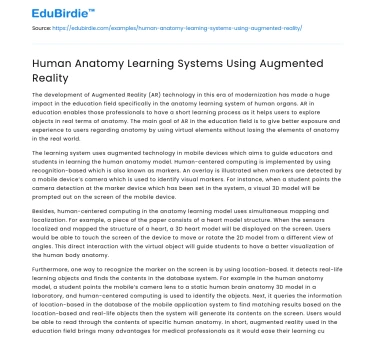The development of Augmented Reality (AR) technology in this era of modernization has made a huge impact in the education field specifically in the anatomy learning system of human organs. AR in education enables those professionals to have a short learning process as it helps users to explore objects in real terms of anatomy. The main goal of AR in the education field is to give better exposure and experience to users regarding anatomy by using virtual elements without losing the elements of anatomy in the real world.
The learning system uses augmented technology in mobile devices which aims to guide educators and students in learning the human anatomy model. Human-centered computing is implemented by using recognition-based which is also known as markers. An overlay is illustrated when markers are detected by a mobile device’s camera which is used to identify visual markers. For instance, when a student points the camera detection at the marker device which has been set in the system, a visual 3D model will be prompted out on the screen of the mobile device.
Save your time!
We can take care of your essay
- Proper editing and formatting
- Free revision, title page, and bibliography
- Flexible prices and money-back guarantee
Besides, human-centered computing in the anatomy learning model uses simultaneous mapping and localization. For example, a piece of the paper consists of a heart model structure. When the sensors localized and mapped the structure of a heart, a 3D heart model will be displayed on the screen. Users would be able to touch the screen of the device to move or rotate the 2D model from a different view of angles. This direct interaction with the virtual object will guide students to have a better visualization of the human body anatomy.
Furthermore, one way to recognize the marker on the screen is by using location-based. It detects real-life learning objects and finds the contents in the database system. For example in the human anatomy model, a student points the mobile’s camera lens to a static human brain anatomy 3D model in a laboratory, and human-centered computing is used to identify the objects. Next, it queries the information of location-based in the database of the mobile application system to find matching results based on the location-based and real-life objects then the system will generate its contents on the screen. Users would be able to read through the contents of specific human anatomy. In short, augmented reality used in the education field brings many advantages for medical professionals as it would ease their learning curve to study human anatomy.
Did you like this example?
Make sure you submit a unique essay
Our writers will provide you with an essay sample written from scratch: any topic, any deadline, any instructions.
Cite this paper
-
APA
-
MLA
-
Harvard
-
Vancouver
Human Anatomy Learning Systems Using Augmented Reality.
(2021, August 04). Edubirdie. Retrieved December 25, 2024, from https://edubirdie.com/examples/human-anatomy-learning-systems-using-augmented-reality/
“Human Anatomy Learning Systems Using Augmented Reality.” Edubirdie, 04 Aug. 2021, edubirdie.com/examples/human-anatomy-learning-systems-using-augmented-reality/
Human Anatomy Learning Systems Using Augmented Reality. [online].
Available at: <https://edubirdie.com/examples/human-anatomy-learning-systems-using-augmented-reality/> [Accessed 25 Dec. 2024].
Human Anatomy Learning Systems Using Augmented Reality [Internet]. Edubirdie.
2021 Aug 04 [cited 2024 Dec 25].
Available from: https://edubirdie.com/examples/human-anatomy-learning-systems-using-augmented-reality/
copy






 Stuck on your essay?
Stuck on your essay?

